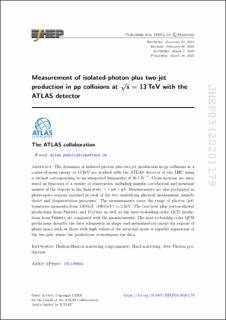Measurement of isolated-photon plus two-jet production in pp collisions at √s = 13 TeV with the ATLAS detector
Aad, Georges; Abbott, Brad; Abbott, Dale C.; Abed Abud, Adam; Abeling, Kira; Abhayasinghe, Deshan Kavishka; Abidi, Syed Haider; AbouZeid, Hass; Abraham, Nadine L.; Abramowicz, Halina; Bjørke, Kristian; Bugge, Magnar Kopangen; Cameron, David Gordon; Catmore, James Richard; Garonne, Vincent; Gramstad, Eirik; Hellesund, Simen; Morisbak, Vanja; Oppen, Henrik; Ould-Saada, Farid; Pedersen, Maiken; Read, Alexander Lincoln; Rye, Eli Bæverfjord; Røhne, Ole Myren; Sandaker, Heidi; Vadla, Knut Oddvar Høie; Buanes, Trygve; Djuvsland, Julia Isabell; Eigen, Gerald; Fomin, Nikolai; Lee, Graham Richard; Lipniacka, Anna; Martin dit Latour, Bertrand; Stugu, Bjarne; Træet, Are Sivertsen; Abreu, Henso; Abulaiti, Yiming; Acharya, Bobby S.; Achkar, Baida; Adachi, Shunsuke; Adam, Lennart; Adam-Bourdarios, Claire; Adamczyk, Leszek; Adamek, Lukas; Adelman, Jareed; Adersberger, Michael; Adigüzel, Aytül; Adorni, Sofia; Adye, Tim; Affolder, Anthony Allen; ATLAS, Collaboration
Journal article, Peer reviewed
Published version

Åpne
Permanent lenke
https://hdl.handle.net/11250/2756168Utgivelsesdato
2020-03-30Metadata
Vis full innførselSamlinger
Sammendrag
The dynamics of isolated-photon plus two-jet production in pp collisions at a centre-of-mass energy of 13 TeV are studied with the ATLAS detector at the LHC using a dataset corresponding to an integrated luminosity of 36.1 fb−1. Cross sections are measured as functions of a variety of observables, including angular correlations and invariant masses of the objects in the final state, γ + jet + jet. Measurements are also performed in phase-space regions enriched in each of the two underlying physical mechanisms, namely direct and fragmentation processes. The measurements cover the range of photon (jet) transverse momenta from 150 GeV (100 GeV) to 2 TeV. The tree-level plus parton-shower predictions from SHERPA and PYTHIA as well as the next-to-leading-order QCD predictions from SHERPA are compared with the measurements. The next-to-leading-order QCD predictions describe the data adequately in shape and normalisation except for regions of phase space such as those with high values of the invariant mass or rapidity separation of the two jets, where the predictions overestimate the data.
